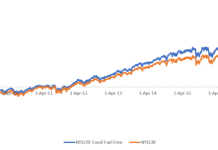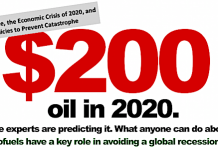Tom Konrad CFA
The last ten years have brought a structural change to the world oil market, with changes in demand increasingly playing a role in maintaining the supply/demand balance. These changes will come at an increasingly onerous cost to our economy unless we take steps to make our demand for oil more flexible.
We’re not running out of oil. There’s still plenty of oil still in the ground. Oil which was previously too expensive to exploit becomes economic with a rising oil price. To the uncritical observer, it might seem as if there is nothing to worry about in the oil market.
Unfortunately, there is something to worry about, at least if we want a healthy economy. The new oil reserves we’re now exploiting are not only more expensive to develop, but they also take much longer between the time the first well is drilled and the when the first oil is produced. That means it takes longer for oil supply to respond to changes in price.
In economic terms, the oil supply is becoming less elastic as new oil supplies come increasingly from unconventional oil. Elasticity is the term economists use to describe how much supply or demand responds to changes in price. If a small change in price produces a large change in demand, demand is said to be elastic. If a large change in price produces a small change in supply, then supply is said to be inelastic.
Elasticity of Demand
On the demand side, the elasticity of our demand for oil reflects the options we have to using oil for our daily needs. At a personal level, we can quickly cut our demand for oil a little bit by combining car trips, keeping our tires properly inflated, etc. But the ability to make such reductions is often limited, and even such simple measures come at a cost of time or convenience, which is why we’re not doing them already. If we live in an area without good public transport (as most of us do) we can’t stop driving to work without losing our job, so we keep driving to work, and paying more for the gas to get there.
Over the longer term, our personal options to cut oil consumption increase. We can move closer to work, or to somewhere where we can walk or use public transport to get to our job. This is why the most fuel-efficient vehicle is a moving van.
Replacing a car with a more fuel efficient vehicle is an option for those who have money or credit, but the people who are under the most pressure from high fuel prices are unlikely to be able to afford such options. If they can’t resort to ride sharing or public transport, they may simply lose their jobs because they can’t afford to get there.
The reduction in fuel use that comes from people losing their jobs and no longer commuting to work also contributes to the elasticity of demand, and I mention it to highlight the point that while reductions in fuel use can be benign (properly inflated tires, for instance), they can also be harmful to the economy. Reductions in demand due to high prices are often called demand destruction, and it’s just as unpleasant as it sounds.
Elasticity of Supply
Since our options for reducing oil demand in response to rising prices range from inconvenient to expensive, to downright painful, it’s clear why the media and politicians focus so much attention on the other half of the equation: When supply adapts to changes in demand, voters don’t have to make uncomfortable choices.
But there are also limits to the ability of oil supply to adjust. Most OPEC nations, including Saudi Arabia, need at least a $100/bbl for oil to keep their budgets in balance, so why would they increase production to reduce the price below that? In fact, as (subsidized and hence inelastic) OPEC domestic consumption continues to increase faster than supply, OPEC net exports will continue to fall, further raising the price needed to balance exporters’ budgets.
While fiscal issues constrain OPEC’s elasticity of supply, geology and politics constrain oil supply elsewhere. Brazil’s giant pre-salt fields, like deep water discoveries in the Gulf of Mexico and elsewhere, are much more expensive and slow to develop than were past discoveries. Canada’s tar sands are large mining operations, and are similarly slow and expensive to develop.
Put simply, if the oil were quick and easy to get at, we’d have gotten it already. All these factors mean that the elasticity of oil supply is falling, so oil demand has to adjust more in response to changes in price than in the past.
Data
Since there is little reason to assume that the elasticity of oil demand has changed significantly (do we have more options for doing without oil than we did ten or twenty years ago?) while the elasticity of oil supply has fallen, we have to expect that overall oil price elasticity has fallen as well, and these changes should show up in oil market data.
Using oil annual supply, price and consumption data from the EIA and IEA, and making some back-of the envelope adjustments to account for the difference between their different definitions of what constitutes oil, I made some estimates of the price elasticity of oil supply and demand.
Since neither demand nor supply can respond instantly to changes in price, I first had to estimate the average reaction time. To do this, I looked at the correlation between changes in the oil price and changes in supply and demand with various lags. I used price and volume changes over a period of three years because three year changes gave me the strongest results, although one and two year changes were similar.
Below you can see the correlations between three year changes US and worldwide supply and demand with three year changes in US oil prices (WTI) and world oil prices (Brent), after various lags:

Note that we’re looking for negative correlation between price and demand (we use less oil when we have to pay more for it), and positive correlation between price and supply (companies produce more oil if they can get more money for it.)
From the chart, we can see that world oil supply has historically taken about one year to respond to changes in world prices (the blue line peaks at 40% correlation with a one year lag), while domestic US oil production (supply) has typically taken about four years to respond to changes in the oil price, but that response is much stronger than the response of world supply.
The difference between the response between US and world oil supply makes sense because domestic oil production operates in a much freer market than world oil supply, where changes are mostly dominated by political decisions in a few OPEC nations. Political decisions are quicker than drilling new wells (one year as opposed to four), but they are only about half as responsive to changes in price.
On the demand side, we see very little response to changes in price at all. The correlation between demand and price is always positive, showing that changes in supply have accounted for virtually all of the market response to oil price changes over the period.
Changes Over Time
To test
my hypothesis that supply is becoming less elastic, I split my data set into two periods, one from 1987 to 2000, and one from 2001 to 2010. If the hypothesis is correct, we will see less supply and more demand price response in the later period than in the earlier one.
The graphs which follow show significant changes in how both supply and demand respond to changes in price. Perhaps the most significant change is that we now see a response in the demand for oil to the oil price.
In the early period, only US demand for oil shows a small response to price, with a slight negative correlation (-30%) between three year changes in US demand and changes in price. World oil demand still shows no measurable price response. I take this to indicate that at the end of the last century, Americans responded to changes in the oil price by using the relatively easy options such as eliminating discretionary trips when oil prices rose, but price was not an important factor for determining world oil consumption.

In the later period, the US demand no longer shows a short-term response to rises in the oil price, perhaps because the easy reductions in oil use have already been made, but we now see a relatively strong response to higher oil prices (with a -90% correlation) over a period of four years for both US and world oil demand. This probably corresponds to such changes as purchasing more efficient vehicles, and minimizing commutes by moving closer to work or working more from home.

Confirmation
World oil demand’s very significant response to changes in the oil price implies that demand is now playing a much bigger role in the adjustments the oil market makes to changes in price than it has in the past.
Because oil supply has become less elastic and less responsive to changes in price, oil prices have become much more volatile in order to force market adjustments.
The chart below shows that while the magnitude (either up or down) of annual changes in supply and consumption have been in the 3% to 7% range for the last quarter of a century, the magnitude of oil price changes has been rising relentlessly. In the 1990s, oil prices usually changed by an average of 25% or less per year, while they now typically change by three or four times that amount in any given year.

If the price elasticity of the oil market had not been falling over time, the increasing magnitude of changes in oil prices would have produced a similar increase in the magnitude changes in oil supply and demand.
As the Market For Oil Becomes Less Flexible, We Should Make the Market for Transportation Services More Flexible to Compensate
If what we care about are the effects on the economy, it does not matter how much oil is in the ground. Over the last ten years, we have see a structural change in the oil market which will continue to have far-reaching effects on the economy even if we manage to increase the amount of oil produced.
Before 2000, oil supply did the heavy lifting when it came to balancing supply and demand in the oil market. That is no longer the case, and the oil price signal has grown significantly stronger in order to elicit a response in demand.
With 2% of the world’s oil reserves, changes in the US supply of oil will remain insignificant in the world oil supply demand picture, developments in the Bakken shale and cheer leading from political leaders notwithstanding. On the other hand, as the consumer of a quarter of the world’s oil supply, we can have a significant effect on the world oil market by making sure that our economy can adjust quickly and easily to changes in the oil price.
What measures can we take to increase the elasticity of oil demand, and reduce the pain of demand destruction? Measures which increase our citizen’s options for reducing oil use.
- Increased investment in alternative modes of transport, such as mass transit (both buses and rail), bike lanes, bike and car sharing, and walking improvements to allow many more workers the option of getting to their jobs without the use of a personal car.
- Improvements in our nation’s rail system to allow more freight to be shifted from truck to rail.
- Increasing gas taxes slowly and predictably over time to both fund the above improvements, and to signal to consumers that they need to prepare for long term higher prices by purchasing more efficient vehicles and changing where they live so that they have the ability to reduce their driving.
- The use of road congestion pricing, pay as you drive insurance, and other price signals that give people the right market signals and enhance the most efficient use of our nation’s roadways.
- Encouraging the electrification of transport (including the alternative transport options mentioned above) to provide transport options which are not dependent on oil.
In short, we need to make the market for transportation services more efficient by encouraging new entrants (mass transit, bikes, trains) and competition with the incumbent car/internal combustion engine infrastructure. Competition within the car infrastructure should also be encouraged by sending price signals such as the slowly and predictably increasing gas tax mentioned above to better reflect the dangers to our economy posed by the new oil market regime.
Thanks to Jim Hansen of Ravenna Capital Management for his help. This article was first published on Forbes.com.






